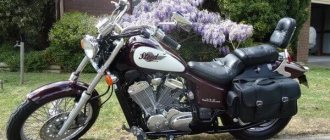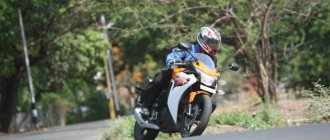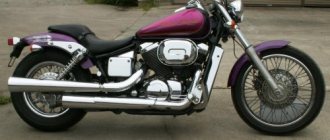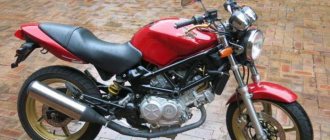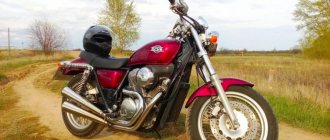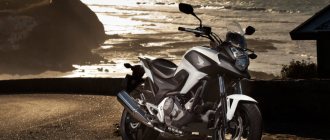Review of the Honda Steed 600 motorcycle
I drove a Steed 600 1992.
from 2005 to the middle of last season. — Nothing broke except the subframe, because there’s no point in carrying a passenger and a healthy backpack at the same time. — In addition to the original ones, I inserted valve springs from a VAZ 2108 into the feathers. Good. — Landing on Steed for short people. Installing a high steering wheel and stems solved everything. — The tank, in my opinion, was very small before 1995 — 9 liters. In RB it dried up. — There are Steeds with the NV600 frame markings; they don’t have a passenger backrest (I had one). I installed a tuned one from Givi, but it is clumsily attached, which, coupled with overload, caused a crack in the subframe. — Sometimes they tell you how difficult it is to remove the battery. They lie, scoundrels, everything is filmed in one, two, three times. — The front turn signals, unlike the 400, are mounted on feathers. When dropped, they turn out and form a conical dent on the tank. — The stories that long-range shooting is prohibited on Steed are also blatant lies . But it’s still better to be alone. STEED 600 IS A GOOD, GOOD MOTORCYCLE!
. But it’s still better to be alone. STEED 600 IS A GOOD, GOOD MOTORCYCLE!
It’s a good motorcycle, reliable, beautiful, there’s a lot of information on it on the Internet, there’s a lot of information on hand - so there’s no problem with advice and spare parts. Of the minuses - there is still little power, the speed is a comfortable speed of 100 km/h - it may not be enough on the highway, it is not very suitable for large or overweight people, and yet the motorcycle is more suitable for asphalt surfaces - I rode it 240 km on a dirt road and back - it came off and Everything that was possible came loose (there was a second steed in the pair - the places where the breaks were identical) - after the trip I installed a grower almost everywhere.
I like steed. skated two seasons on different ones. both on fully standard ones and on modifications from long forks to beavers with crackers. 400 and 600 are no different in power and dynamics at all. the difference of 3 forces is not noticeable. except in price. You realize that you have six hundred under your ass just by the number of gears. The maximum speed on both is 120. Anyone who says that they are going 140 or more is either lying or their speedometer is lying. There were about a dozen different Steeds, with standard speedometers and with fashionable ones - everywhere the figure was extreme 120. This is perhaps the only drawback of this motorcycle. In the city you basically don’t notice this, everything is quite satisfactory, but outside the city it’s already starting to get annoying. At a maximum of 120 it’s always pleasant to drive. the engine is in last gear and under the cut-off, the vibration and intense roar of the boilers begin to strain. so the cruising ride is more or less comfortable 80-90. It’s quite normal to drive 200-300 km at a time, if only because the roads don’t allow you to constantly drown over a hundred. I drove further, but there are times when this maximum speed threshold is annoying.
Otherwise the motorcycle has a lot of advantages. reliable, easy to maintain, convenient, lends itself very well to all kinds of alterations, from long custom ones to cropped beavers, and the resulting devices are quite decent.
I can also add that a lot of them come from Japan, the Japanese really like to cut steeds and all sorts of crap for this purpose. very often they come with a fork stem. This stem is naturally made not by the angle of the steering column, but by traverses, which does not have a particularly favorable effect on control, and the stem with a high steering wheel begins to wobble at speeds above 80, you have to fight this. Of course, long-distance driving is stressful, your arms get very tired. in short, all these beauties are just for moving around the city from point A to point B.
All in all, a good motorcycle for those who do not strive for speed records and LJ standards. With my height of 172 and my weight of just over 60, it’s perfect in all respects.
So, I rode the first season on a Honda VLX 600. Before this motorcycle I had absolutely no experience riding cruisers, I rode a light endurike for 4 seasons, and the first feeling was - How heavy it is! Well, yes, adding 100 kg to your usual weight won’t seem like much. But nothing, I rolled quickly, learned to cope with the innate desire of the motorcycle to turn into a turn (for this reason I dropped the bike twice at near-zero speeds) and began to truly enjoy it. Some will say that 600 cubic meters is not enough for a cruiser, but as for me, its 36 horses and 51 Newton Meters are quite enough. On the highway 100-120 is quite easy, without strain. When overtaking, it picks up 130 - 140 quite briskly, but the complete absence of any wind protection makes riding at such a speed extremely uncomfortable; you have to hold on tightly to the steering wheel so as not to be blown off the motorcycle. A comfortable speed is 100-110, but there is one minus - the stock steering wheel is very tilted back and there are no adjustments in it. My height is 186, my arms are long, and when moving along the highway my elbows get tired, I want to straighten them. The problem was solved by purchasing steering columns and the steering wheel itself from Shadovka 750. The steering wheel was bolt-on, I adjusted it with a slight tilt forward - it became comfortable for my hands. As for the acceleration dynamics, the manufacturer does not provide data, but my measurements showed something like 7.5-8.0 seconds. It's quite enough to kick the boys in Priors at the traffic lights. ) Initially, I got the moto with the fork feathers snotty and piercing the bumps. The snotty problem was solved by replacing the fluid and seals/anthers. Additionally, I made minor changes to the design of the fork itself - instead of the stock extension tubes inside the stays, I installed 32mm polypropylene pipes shortened by 40mm relative to the stock. Additionally, I installed one valve spring from VAZ. The fork stroke increased, the breakdowns disappeared completely. What else was done - I welded a trunk from a 10mm rod and pieces of iron, made something like crash pegs from an inch water pipe. This theme works - in both collapses, the motor rested on the pipe and the tank was not damaged. When the season was already over, I decided to add a little style and functionality. The stock gas tank has a capacity of only 9 liters and on long-distance trips there is always the worry that I won’t make it to the next gas station, so when traveling I carried a plastic one and a half truckload of gasoline with me. Then a rather chewed stainless steel flask with a capacity of 1.2 liters broke off for me. A sticker was peeled off a bottle of whiskey, stuck to a flask, and the whole thing was generously filled with semi-matte varnish. Using a simple bracket and trouser belts, I attached the flask to the motorcycle. I think it turned out quite nicely, and a liter of gasoline in a flask “just in case” allows you to worry much less.
What else - there are some problems with the carburetor or both at once - during intense acceleration, when the throttle is open to full, the thrust is initially uniform, then closer to the maximum speed a tr-ta-ta sound appears, similar to a cut-off, followed by a good kick under rear and the motorcycle begins to accelerate simply brutally, right up to maximum speed. The maximum speed, by the way, in 2nd gear is 100 km/h according to the speedometer. The 600, unlike its younger brother, has a few 400 gears, but they are stretched out and the maximum torque level is much lower - from 3500 rpm, so having only 4 gears is not at all annoying. You can quite easily start off in 2nd gear and accelerate to 100 in it. There were also some minor “tunings”. The stock turn signals on the front, which look more like the ears of a Cheburashka, were replaced with Chinese handicrafts, inside of which, in addition to the bulbs, orange LEDs were installed to preserve the existing function of side lights in the turn signals. I tried to install double-thread tabs, but they get very hot and melt the turn signal housing. It’s not for nothing that the Japanese made the turn signals so huge - they need air inside for cooling - 8 watts in size is a lot. LEDs consume significantly less and do not heat up at all. And the appearance suits me quite well. Also on the electrical side, I installed a cigarette lighter socket under the left plastic, in the place where the manufacturer intended the tools to be stored. I connected it directly to the ignition switch via a fuse and a two-position toggle switch. In one position of the toggle switch, the cigarette lighter is constantly powered, in the second - only when the ignition is on. I inserted a car charger into it, providing a charging current of up to 3A. It makes no sense to set less power - with navigation running, the phone will consume more than the charge. The wire should also be taken to provide high current. Weak wiring limits the charging current. From a standard phone case, a piece of hardware, a bolt and a magnet, I made a smartphone holder for the steering wheel, connected it to power from the charger. Yes. About consumption. On the highway in 100-110 mode, about 5 liters per hundred. In the city it's about 7-8. It's a bit much, but it's not really a big concern. About the oil. I didn’t bother with motor oils, I filled it with regular engine Ravenol 5W40 and happily drove 7,500 km on it. There is no oil burner at all. From the moment of purchase there was some slipping of the clutch when shifting to 3rd gear, which lasted a couple of seconds. Then it disappeared and is repeated extremely rarely. Well, maybe once a week for daily rides. So far I've given up on this matter - it doesn't bother me. If it continues, I'll pull the clutch. What else has been done - the rear turn signals have been moved closer to the license plate, the license plate mount is reinforced with metal tires. The Steeds’ eternal problem “the number fell off” has been completely solved. Plans for the next season are to install leg stems, the stock footpegs are a bit close. I would like to push them forward by 5 centimeters. Maybe I'll add extra light. A stock headlight, even with a good Knight Breaker bulb, is not enough.
Well, that’s the whole report for the past season. The motor is thickly coated with Teflon polish, oil is poured into the cylinders, the transmission chain is washed and generously lubricated, the battery is removed and taken home. It sits in the garage, covered with a construction awning, waiting for the next season.
Steed Black Classic
Bobber based on Honda VLX (Steed/Shadow) can be built with a volume of 400 cm3, 600 cm3.
If you need advice on engine size and power, give us a call and we can help you make your choice.
We build motorcycles only from donors in excellent technical condition and with a transparent legal history. By purchasing a motorcycle from us, you can concentrate entirely on appearance, performance and comfort, leaving the routine to us.
Replacement of necessary consumables is included in the cost of construction, so you always receive a motorcycle serviced and ready for the season.
BROBBOBBER does not welcome uncomfortable motorcycles with a “dry” frame (hard trail), of course, unless you ask for it - therefore, each of ours has a full-fledged, comfortable suspension by default.
At your request, LED optics with excellent light beam brightness with a glow temperature of 4000-5000 can be installed on any motorcycle. Turn indicators and brake lights can also be diode.
Model features:
Great city bike. Small dimensions, convenient for girls. Easy to operate, mobile between rows. Suitable as a first motorcycle. It is possible to install a removable passenger seat. Moderate fuel consumption. Low price.
Characteristics 400cc
| Model | Honda Steed 400 |
| Motorcycle type | cruiser |
| Year of issue | 1988-2001 |
| Frame | steel tubular |
| engine's type | 2-cylinder, 4-stroke, V-shaped |
| Working volume | 398 cm³ |
| Bore/Stroke | 64.0 x 62.0 mm |
| Compression ratio | 10.0:1 - Steed 400, 1988-1995 9.8:1 - Steed 400, December 1995 to 2001 |
| Cooling | liquid |
| Number of valves per cylinder | SOHC, 3 valves per cylinder |
| Fuel supply system | carburetor, 2x Keihin 34 mm (VDD0) |
| Ignition type | transistor |
| Maximum power | 30.0 hp (22.0 kW) at 7500 rpm - Steed 400 (1988-1994) 31.0 hp (22.8 kW) at 7500 rpm – Steed 400 (1995-2001) |
| Maximum torque | 32.0 Nm (3.3 kg*m) at 5500 rpm – Steed 400 (1988-1994) 33.0 Nm (3.4 kg*m) / 5500 rpm – Steed 400 (1995-2000) 33.0 Nm (3.4 kg*m) / 6000 rpm – Steed 400 (2001) |
| Transmission | 5-speed |
| type of drive | chain |
| Front tire size | 100/90-19 57S 90/90-21 54S - VLS |
| Rear tire size | 170/80-15 77S |
| Front brakes | 1 disc, 296 mm, 2-piston caliper |
| Rear brakes | drum |
| Front suspension | telescopic fork - VLS |
| Rear suspension | pendulum with monoshock absorber |
| Motorcycle length | 2310 mm 2335 mm - VLS |
| Motorcycle width | 760 mm 705 mm – VLX with drag handlebar, VCL 865 mm – VSE 765 mm – VLS 890 mm – VLX (2001) |
| Motorcycle height | 1130 mm 1105 mm – VLX with drag handlebar, VCL 1120 mm – VSE, VLX (2001) 1115 mm – VLX (1998-2000), VLS |
| Wheelbase | 1600 mm 1620 mm – VLS |
| Seat height | 680 mm 670 mm - VLX (1998-2001) 650 mm - VLSD |
| Minimum ground clearance (clearance) | 140 mm 130 mm - VLX (1998-2001), VLS |
| Acceleration to 100 km/h | 11.1 sec |
| Maximum speed | 130 km/h |
| Gas tank capacity | 9.0 l – Steed 400 (1988-1992) 11.0 l – Steed 400 (1993-2001) 9.7 l - VLS |
| Motorcycle weight (dry) | 196 kg – Steed 400 (1988-1989) 199 kg – Steed 400 VLX (1990-1992) 201 kg – Steed 400 VLX (1993) 204 kg – Steed 400 VLX (1994-1997), VCL 203 kg – VSE, VLX (1998-2001) 211 kg – VLS |
| Motorcycle weight (curb) | 208 kg – Steed 400 (1988-1989) 211 kg – Steed 400 VLX (1990-1992) 214 kg – Steed 400 VLX (1993) 217 kg – Steed 400 VLX (1994-1997), VCL 216 kg – VSE 215 kg – VLX (1998-2001) 223 kg – VLS |
Characteristics 600cc
| Model | Honda Steed 600 |
| Motorcycle type | cruiser |
| Year of issue | 1988-1995 |
| Frame | steel tubular |
| engine's type | 2-cylinder, 4-stroke, V-shaped |
| Working volume | 583 cm³ |
| Bore/Stroke | 75.0 x 66.0 mm |
| Compression ratio | 9.2:1 |
| Cooling | liquid |
| Number of valves per cylinder | SOHC, 3 valves per cylinder |
| Fuel supply system | carburetor, 2x Keihin 34 mm (VDF1) |
| Ignition type | transistor |
| Maximum power | 36.0 hp (26.5 kW) at 6500 rpm |
| Maximum torque | 44.0 Nm (4.5 kg*m) at 3000 rpm |
| Transmission | 4-speed |
| type of drive | chain |
| Front tire size | 100/90-19 (57S) |
| Rear tire size | 170/80-15 M/C (77S) |
| Front brakes | 1 disc, 296 mm, 2-piston caliper |
| Rear brakes | drum |
| Front suspension | telescopic fork |
| Rear suspension | pendulum with monoshock absorber |
| Motorcycle length | 2310 mm |
| Motorcycle width | 760 mm |
| Motorcycle height | 1130 mm |
| Wheelbase | 1600 mm |
| Seat height | 680 mm |
| Minimum ground clearance (clearance) | 140 mm |
| Acceleration to 100 km/h | 7.9 sec |
| Maximum speed | 150 km/h |
| Gas tank capacity | 9.0 l – Steed 600 (1988-1992) 11.0 l – Steed 600 (1993-1995) |
| Motorcycle weight (dry) | 196 kg – Steed 600 (1988-1989) 199 kg – Steed 600 (1990-1992) 201 kg – Steed 600 (1993) 204 kg – Steed 600 (1994-1995) |
| Motorcycle weight (curb) | 208 kg – Steed 600 (1988-1989) 211 kg – Steed 600 (1990-1992) 214 kg – Steed 600 (1993) 217 kg – Steed 600 (1994-1995) |
